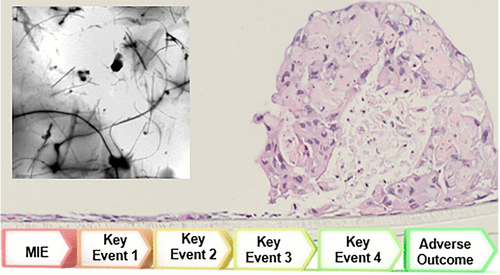Our official English website, www.x-mol.net, welcomes your
feedback! (Note: you will need to create a separate account there.)
Use of EpiAlveolar Lung Model to Predict Fibrotic Potential of Multiwalled Carbon Nanotubes.
ACS Nano ( IF 15.8 ) Pub Date : 2020-03-13 , DOI: 10.1021/acsnano.9b06860 Hana Barosova 1 , Anna G Maione 2 , Dedy Septiadi 1 , Monita Sharma 3 , Laetitia Haeni 1 , Sandor Balog 1 , Olivia O'Connell 2 , George R Jackson 2 , David Brown 4 , Amy J Clippinger 3 , Patrick Hayden 2, 5 , Alke Petri-Fink 1, 6 , Vicki Stone 4 , Barbara Rothen-Rutishauser 1
ACS Nano ( IF 15.8 ) Pub Date : 2020-03-13 , DOI: 10.1021/acsnano.9b06860 Hana Barosova 1 , Anna G Maione 2 , Dedy Septiadi 1 , Monita Sharma 3 , Laetitia Haeni 1 , Sandor Balog 1 , Olivia O'Connell 2 , George R Jackson 2 , David Brown 4 , Amy J Clippinger 3 , Patrick Hayden 2, 5 , Alke Petri-Fink 1, 6 , Vicki Stone 4 , Barbara Rothen-Rutishauser 1
Affiliation

|
Expansion in production and commercial use of nanomaterials increases the potential human exposure during the lifecycle of these materials (production, use, and disposal). Inhalation is a primary route of exposure to nanomaterials; therefore it is critical to assess their potential respiratory hazard. Herein, we developed a three-dimensional alveolar model (EpiAlveolar) consisting of human primary alveolar epithelial cells, fibroblasts, and endothelial cells, with or without macrophages for predicting long-term responses to aerosols. Following thorough characterization of the model, proinflammatory and profibrotic responses based on the adverse outcome pathway concept for lung fibrosis were assessed upon repeated subchronic exposures (up to 21 days) to two types of multiwalled carbon nanotubes (MWCNTs) and silica quartz particles. We simulate occupational exposure doses for the MWCNTs (1-30 μg/cm2) using an air-liquid interface exposure device (VITROCELL Cloud) with repeated exposures over 3 weeks. Specific key events leading to lung fibrosis, such as barrier integrity and release of proinflammatory and profibrotic markers, show the responsiveness of the model. Nanocyl induced, in general, a less pronounced reaction than Mitsui-7, and the cultures with human monocyte-derived macrophages (MDMs) showed the proinflammatory response at later time points than those without MDMs. In conclusion, we present a robust alveolar model to predict inflammatory and fibrotic responses upon exposure to MWCNTs.
中文翻译:

使用EpiAlveolar肺模型预测多壁碳纳米管的纤维化潜力。
纳米材料的生产和商业用途的扩展增加了在这些材料的生命周期(生产,使用和处置)中人体的潜在暴露。吸入是接触纳米材料的主要途径。因此,评估其潜在的呼吸危害至关重要。本文中,我们开发了一个三维肺泡模型(EpiAlveolar),该模型由人原发性肺泡上皮细胞,成纤维细胞和内皮细胞组成,带有或不带有巨噬细胞,可预测对气溶胶的长期反应。在对模型进行全面表征后,基于对肺纤维化不良结局途径概念的反复炎性和促纤维化反应,对两种类型的多壁碳纳米管(MWCNT)和石英石英颗粒进行反复亚慢性暴露(长达21天),进行了评估。我们使用气-液界面暴露装置(VITROCELL Cloud)模拟了MWCNT的职业暴露剂量(1-30μg/ cm2),并在3周内重复暴露。导致肺纤维化的特定关键事件,例如屏障完整性以及促炎性和纤维化标记物的释放,显示了模型的响应能力。通常,Nanocyl诱导的反应不如Mitsui-7明显,与人单核细胞衍生的巨噬细胞(MDM)相比,Nocyl培养物在较晚的时间点显示出促炎反应。总之,我们提出了一个健壮的肺泡模型,以预测暴露于MWCNTs后的炎症和纤维化反应。导致肺纤维化的特定关键事件,例如屏障完整性以及促炎性和纤维化标记物的释放,显示了模型的响应能力。通常,Nanocyl引起的反应不如Mitsui-7明显,与人单核细胞衍生的巨噬细胞(MDM)相比,Nocyl培养物在较晚的时间点显示出促炎反应。总之,我们提出了一个健壮的肺泡模型,以预测暴露于MWCNTs后的炎症和纤维化反应。导致肺纤维化的特定关键事件(例如屏障完整性以及促炎性和纤维化标记物的释放)显示了模型的响应能力。通常,Nanocyl引起的反应不如Mitsui-7明显,与人单核细胞衍生的巨噬细胞(MDM)相比,Nocyl培养物在较晚的时间点显示出促炎反应。总之,我们提出了一个健壮的肺泡模型,以预测暴露于MWCNTs后的炎症和纤维化反应。
更新日期:2020-03-13
中文翻译:

使用EpiAlveolar肺模型预测多壁碳纳米管的纤维化潜力。
纳米材料的生产和商业用途的扩展增加了在这些材料的生命周期(生产,使用和处置)中人体的潜在暴露。吸入是接触纳米材料的主要途径。因此,评估其潜在的呼吸危害至关重要。本文中,我们开发了一个三维肺泡模型(EpiAlveolar),该模型由人原发性肺泡上皮细胞,成纤维细胞和内皮细胞组成,带有或不带有巨噬细胞,可预测对气溶胶的长期反应。在对模型进行全面表征后,基于对肺纤维化不良结局途径概念的反复炎性和促纤维化反应,对两种类型的多壁碳纳米管(MWCNT)和石英石英颗粒进行反复亚慢性暴露(长达21天),进行了评估。我们使用气-液界面暴露装置(VITROCELL Cloud)模拟了MWCNT的职业暴露剂量(1-30μg/ cm2),并在3周内重复暴露。导致肺纤维化的特定关键事件,例如屏障完整性以及促炎性和纤维化标记物的释放,显示了模型的响应能力。通常,Nanocyl诱导的反应不如Mitsui-7明显,与人单核细胞衍生的巨噬细胞(MDM)相比,Nocyl培养物在较晚的时间点显示出促炎反应。总之,我们提出了一个健壮的肺泡模型,以预测暴露于MWCNTs后的炎症和纤维化反应。导致肺纤维化的特定关键事件,例如屏障完整性以及促炎性和纤维化标记物的释放,显示了模型的响应能力。通常,Nanocyl引起的反应不如Mitsui-7明显,与人单核细胞衍生的巨噬细胞(MDM)相比,Nocyl培养物在较晚的时间点显示出促炎反应。总之,我们提出了一个健壮的肺泡模型,以预测暴露于MWCNTs后的炎症和纤维化反应。导致肺纤维化的特定关键事件(例如屏障完整性以及促炎性和纤维化标记物的释放)显示了模型的响应能力。通常,Nanocyl引起的反应不如Mitsui-7明显,与人单核细胞衍生的巨噬细胞(MDM)相比,Nocyl培养物在较晚的时间点显示出促炎反应。总之,我们提出了一个健壮的肺泡模型,以预测暴露于MWCNTs后的炎症和纤维化反应。











































 京公网安备 11010802027423号
京公网安备 11010802027423号